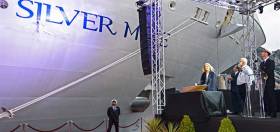Displaying items by tag: Monaco ship naming
Silver Muse Christened in Monaco Before Venetian Society Cruise
#MonacoCeremony - Prince Albert II of Monaco attended Silversea Cruises christening ceremony of their new flagship Silver Muse in the principality, before a pre-inaugural cruise to Greece begins next week, writes Jehan Ashmore.
As previously reported, Afloat had identified Silver Muse is to make an Irish debut later this season with a call to Waterford (Dunmore East) in September. The 40,700 tonnes cruiseship with just 596 passengers are accommodated in ultra luxurious facilities and pampered by a crew total of 411. The newest cruiseship of the 9-strong Silversea fleet is also to be make a first call to Cork.
The Italian built cruiseship from Fincantieri's yard in Genoa, will operate at the top end of the market. Among the facilities is an exclusive Zàgara Beauty Spa, casino, gym, a 327-seat theatre, eight dining venues and a swimming pool. In addition to offering guests the highest number of large suites in the Silversea fleet, and with the greatest number of connecting suites.
At the red-carpet christening ceremony held last Wednesday at the outer pier of Port Hercule, the glamorous harbour of Monte Carlo saw Silver Muse officially named by Constanza Lefebvre. The daughter of Silversea chairman Manfredi Lefebvre d'Ovidio, was watched by dignitaries and invited guests during the traditional ship’s blessing and champagne bottle-breaking at the bow.
The newcomer is an exciting evolution of their Silver Spirit class and the location of Monaco was chosen for the ceremony as Silversea has its headquarters in Monte Carlo. At the quayside were performances by the Sinfonietta Orchestra of Rome and renowned violinist Charlie Siem.
Silver Muse is to depart from Villefranche neighbouring Nice next Wednesday (3 May) on a ‘Venetian Society Inaugural Cruise’.
Afloat has consulted that the 13-day cruise of Mediterranean gems among them Portofino, Amalfi, Santorini, Kusadasi in Turkay and end in Piraeus, the port for Athens. Fares for society members only are from €8,250 per person based in a Classic Veranda Suite on Deck 5/6.





























































